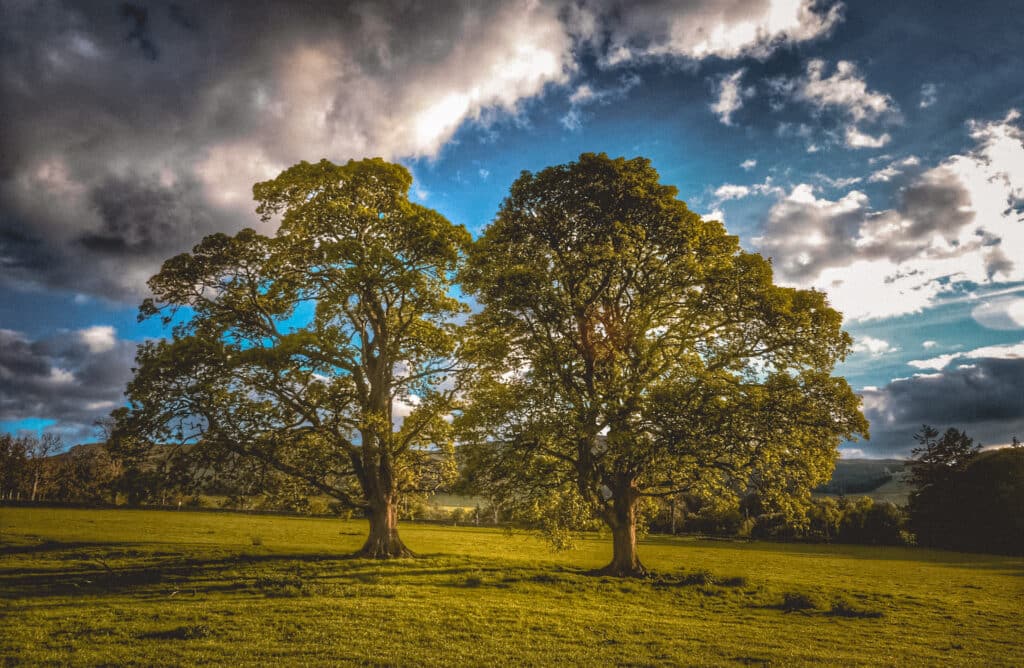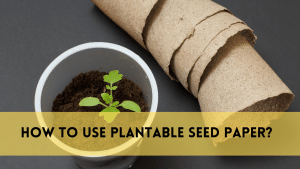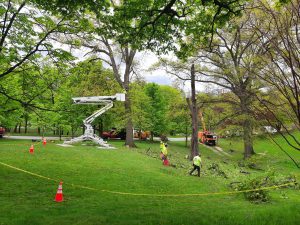Houston’s climate is distinguished by hot and humid summers and moderate winters that can occasionally reach freezing levels. When choosing trees for this location, choose species that can tolerate the heat, periodic drought, and cold spells. Read full Blog and get information about best trees for Houston.
Why Trees Matter in Urban Spaces?
Trees are crucial in urban contexts for a variety of reasons, adding greatly to the quality of life in crowded cities. For starters, they work as natural air cleaners, absorbing harmful pollutants and releasing oxygen. Furthermore, trees provide shade, lowering temperatures and assisting in the cooling of metropolitan areas, thereby decreasing the heat island effect that is common in cities. Their presence improves the visual attractiveness of neighborhoods by establishing pleasant green places for rest and pleasure. Furthermore, trees play an important part in biodiversity conservation by providing habitat for diverse birds, insects, and other creatures. Furthermore, they operate as sound barriers, reducing noise pollution from vehicles and other sources. Overall, the presence of trees in urban areas is critical for environmental, social, and ecological well-being.
Houston’s Unique Climate and Soil Conditions
Houston’s climate and soil characteristics provide a one-of-a-kind habitat for tree development. The city has a humid subtropical climate that has hot, humid summers and moderate winters. This climatic situation poses issues for tree species, necessitating the selection of species capable of withstanding the city’s climatic swings. Furthermore, Houston’s soil makeup varies, ranging from sandy to clayey, influencing plants’ capacity to root and absorb nutrients. Certain trees, such as the Southern Live Oak (Quercus virginiana) and the Mexican Plum (Prunus mexicana), flourish in Houston’s circumstances due to their flexibility to heat, humidity, and a variety of soil types. When selecting trees for the region, it is critical to consider Houston’s specific climate and soil qualities to ensure optimal growth and long-term sustainability in the urban environment.
Importance of Choosing Best Trees For Houston
Because of the city’s unique temperature and soil characteristics, choosing appropriate trees in Houston is critical. Trees play an important role in the urban environment, giving a variety of benefits like as shade, improved air quality, a decreased urban heat island effect, and aesthetic enhancement. Given Houston’s hot and humid environment, it’s critical to select trees that can grow under these conditions, assuring their resilience in the face of harsh temperatures, excessive humidity, and infrequent droughts. Furthermore, trees must adapt to Houston’s different soil types in order to ensure optimal root growth and nutrient uptake. By selecting trees that are well-suited to Houston’s environment, the community may maximize the advantages of urban greenery while reducing care expenses and environmental stress. The correct tree species contribute considerably to the general health and sustainability of the city’s urban landscape, encouraging biodiversity and boosting the quality of life for its citizens.
Factors Affecting the Best Trees For Houston
Several considerations have a considerable impact on the selection of trees ideal for Houston’s landscape. Given the city’s subtropical environment, with hot, humid summers and moderate winters, climate is a significant factor. Tree species must tolerate these circumstances, which include high temperatures and intermittent droughts. Given Houston’s many soil types, soil conditions are critical. For optimal root development and nutrient uptake, the selected trees must adjust to these various soil types. Furthermore, the tree’s growth features, like as size, canopy form, and growth rate, determine its adaptability in urban environments. Tree selection is also influenced by maintenance needs and possible difficulties like as disease resistance and insect susceptibility. In essence, the holistic evaluation of these factors—climate resilience, soil adaptation, growth features, and care requirements—ensures the ideal selection of trees that flourish in Houston’s distinctive urban setting.
Native Trees: Well-Suited Choices, Best Trees For Houston
Due to their adaptation to the city’s peculiar conditions, native trees are a wise option for Houston’s landscape. These trees, which originated in the region or adjacent places, have naturally adapted to Houston’s climate, soil types, and environmental differences.
Native trees, such as Live Oaks (Quercus virginiana) and American Sycamores (Platanus occidentalis), have innate features that complement the city’s characteristics. Their deep roots provide stability, which is critical for Houston’s weather events, as well as important ecological advantages like as enhanced air quality and habitat for local species. Furthermore, native trees frequently require less maintenance once established, demonstrating resistance to pests, diseases, and poor weather conditions. Their knowledge with the local ecosystem makes them an eco-friendly and sustainable choice, contributing to the general health and biodiversity of the environment.
Recommended Non-Native Varieties, Best Trees For Houston
In addition to native trees, Houston’s urban landscape can benefit from a variety of non-native tree species that flourish in the city’s environment. Certain non-native cultivars, such as the Crape Myrtle (Lagerstroemia indica) and the Chinese Pistache (Pistacia chinensis), have specific benefits, such as brilliant colors, distinctive leaves, and adaptation to Houston’s temperature and soil. These non-native trees frequently bring diversity and aesthetic appeal to the surrounding environment, improving the cityscape with various forms, textures, and seasonal interests. They can provide shade, contribute to urban greening efforts, and create attractive landscapes when appropriately incorporated into Houston’s green spaces. However, it’s crucial to consider their growth habits and potential invasiveness to prevent ecological disruption. Consultation with local horticulturists or arborists may help guide the selection of non-native trees that are suited for Houston, ensuring that they compliment the city’s ecosystem without producing any negative consequences.
Planting and Maintenance Tips in Best Trees For Houston
It’s critical to follow specific criteria while planting trees in Houston for maximum development and health. Consider the following crucial recommendations:
Plant in the autumn or early spring. This permits trees to grow roots prior to adverse weather conditions.
Proper Site Selection: Evaluate the location for sunshine, soil quality, and the space required for the tree’s mature growth.
Watering Requirements: Provide appropriate watering, especially during dry months, to guarantee adequate moisture for root growth.
Mulching: Apply mulch around the base of the tree to conserve moisture, control soil temperature, and discourage weed development.
Pruning and trimming: Regularly prune for shape and remove damaged or diseased branches. Over-pruning, on the other hand, can be detrimental to the tree.
Fertilization: Use appropriate fertilizers sparingly to stimulate development, particularly throughout the growing season.
Pest and Disease Management: Keep a look out for common pests and illnesses. Use suitable preventive and therapeutic measures.
Support System: staking or employing support systems for freshly planted trees to enhance stability while roots grow.
Following these methods supports healthy tree development, assuring their long-term well-being and contribute to Houston’s greenery.
FAQS
1. What tree species do well in Houston’s climate?
Houston’s warm and humid environment is ideal for trees such as Live Oaks, Southern Magnolias, Crape Myrtles, and Bald Cypress.
2. Are there low-maintenance trees suitable for Houston homeowners?
Yes, trees like the Chinese Pistache and Vitex take little care once established and are well-suited to Houston’s environment.
3. Which trees in Houston have beautiful fall foliage?
Red Maple, Chinese Pistache, and Ginkgo trees have beautiful fall hues and are popular for their seasonal beauty.
4. How can I choose trees that can weather Houston’s infrequent storms?
Choose resilient species such as Cedar Elm, Live Oak, and Bald Cypress.
5. Are there trees acceptable for Houston’s smaller urban spaces?
Smaller trees, such as the Mexican Plum and Texas Mountain Laurel, are ideal for small settings since they provide beauty without dominating the surroundings.
Conclusion
The importance of choosing the correct trees for Houston’s diverse terrain cannot be stressed. Individuals may make educated decisions by studying the climate, soil conditions, and special requirements. The proper trees not only improve looks but also contribute to a healthy environment and urban ecosystem. Choosing native or well-adapted species improves sustainability and guarantees that trees survive in Houston’s climate while also sustaining local fauna.




